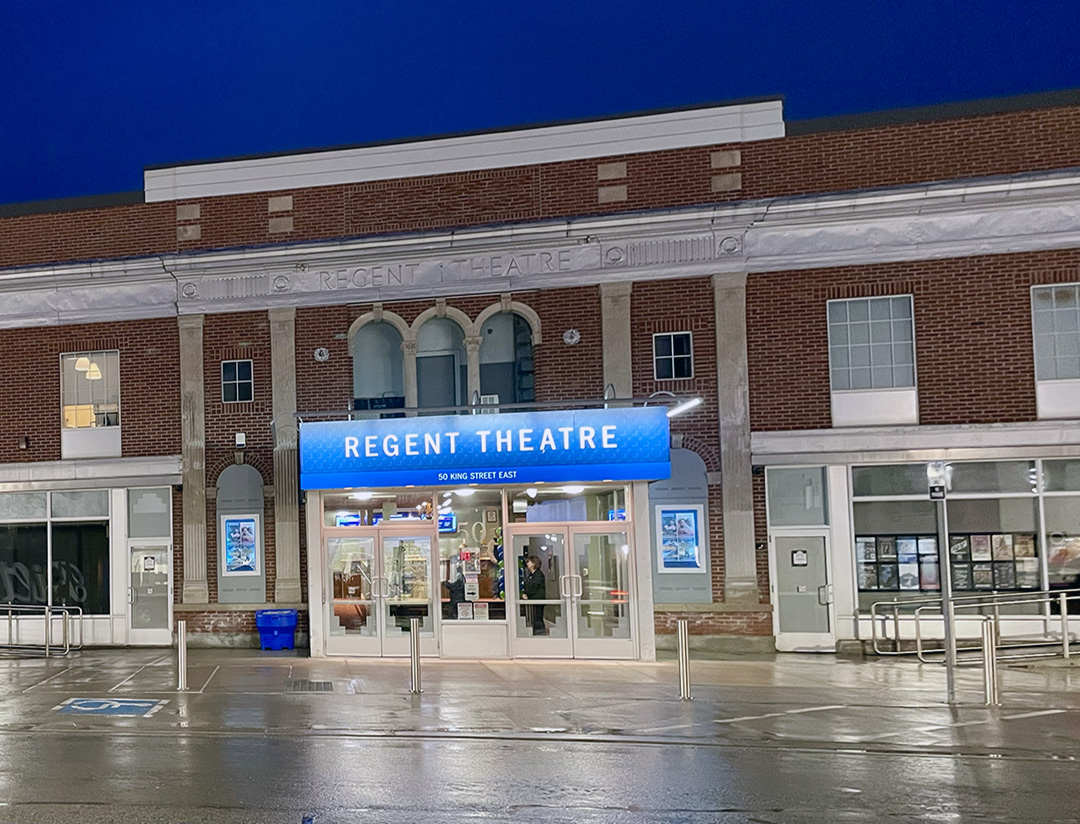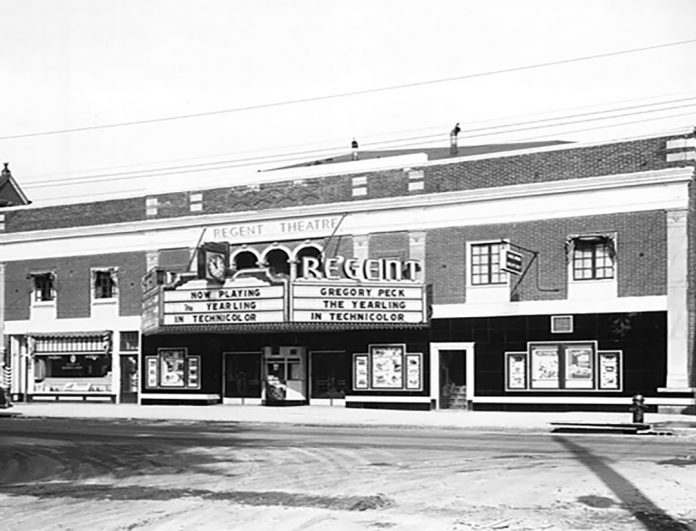Editor’s note: This story was collaboratively produced by reporters Mackenzie Billings and Ganga Rajesh
In October 1919, a crowd gathered outside the newly built Regent Theatre, awaiting its opening.
There were a few performances to mark the occasion. First, Thomas Meighan starred in “The Prince Chap,” a silent film released in 1920.
That night, they also featured “You Wouldn’t Believe It!” a Mack Sennett comedy short film released in 1919 accompanied by Jack Arthur’s orchestra.
Since its inception as a vaudeville and silent film venue, the theatre has undergone a remarkable transformation, evolving into a vibrant cultural hub in the region.
Construction of the Regent Theatre began in March 1919 and it opened on Oct. 16 of that year. The building is situated on the Traditional Territory of the Mississaugas, which is covered by the Williams Treaty, where it still stands today.
“You had lots of people for whom movies were a way of life. If it was Friday and such and such didn’t come to the theatre that night, you knew he was either sick or out of town. People had formed a habit of coming to the theatre no matter what was showing,” said Al Hartshawn, theatre manager in the 1960s, as quoted in the designation proposal for the Regent.
As a result of the excitement of the community building, the theatre quickly became a hub of entertainment in Oshawa, with a full capacity audience attending opening night.

The theatre wasn’t just a big name, though; it set itself apart from other theatres in Canada at the time due to its exciting features.
“The architecture of it was quite unique, the entrance lobby was quite lovely. Finished with Mahogany, and when you first walked in there was the prominence,” said Melissa Cole, a museum coordinator at the Oshawa Museum. “So at the time when it opened, the stage was expandable.”
The expandable stage allowed the Regent to showcase both live performances and movie screenings, making its offerings more diverse than those of other theatres at the time.
With a capacity of 1,100, it was the first theatre in Oshawa to offer a “perfect vision” for its patrons. Additionally, the theatre boasted outstanding acoustic properties and an ambitious lighting system that aimed to enhance the viewing experience.
The theatre was also originally equipped with a water-based air conditioning system, which was pretty unique for the time. It was later replaced with a modern system to maintain a comfortable temperature during hotter periods.
The Regent Theatre was adaptable even at the beginning of its life; at one point, it was used as a community hub during the Second World War.
“They had a lot of local drives, community drives, so things like collecting fat, collecting aluminum and that kind of stuff,” said Jennifer Weymark, an archivist at the Oshawa Museum.
From the 1920s into the 1940s, Leon Osier served as the theatre’s general manager.
To make guns and ammunition, local communities sent scrap metal and tin foil to hubs like these to aid in the war effort. Through Osier’s recycling program, people were able to donate their scrap metal that was sent overseas for the war effort.
Through its nearly 80 years of operation, the Regent Theatre underwent alterations and improvements to meet the changing trends of business.
However, as time went on it seemed the Regent couldn’t keep up with the fast-changing Oshawa community.
“There was a kind of a period of economic downturn and the opening and growth of the Oshawa Centre impacted the downtown area, and you saw that across the entirety of the downtown where businesses had moved out and the region was hit with that as well,” said Weymark.
During a period of economic stagnation, the theatre was struggling to remain profitable. However, as more and more commercial theatres cropped up in the area, such as the Oshawa Centre’s movie theatre, it ultimately closed down.
Until now, it remained relatively unchanged, only changing in minor ways until, in late 1997, the Regent Theatre was transformed into a nightclub known as Adrenalin Rush.
A new era in the theatre’s history began as it transitioned from being a live performance and film screening venue to a lively nightclub after four local businessmen purchased it.
“It would have been late 1990. It still looked like the seats were gone and the floor was kind of flat, but it had the walls, I think if I remember correctly, looked the same. I think there was like a chandelier, so it was an interesting experience,” said Weymark.
The club had seen a lot of the original theatre props removed to create a more nightclub-like atmosphere. However, a few pieces of its original architecture were kept, such as the chandeliers and other light fixtures, in addition to some of its original wall decor.
However, the nightclub phase of the Regent Theatre was relatively short-lived.
After a few years of operation, Adrenalin Rush closed its doors due to the competition of other entertainment venues and changing nightlife trends.
Following its closure as a nightclub, the Regent Theatre was eventually restored and opened to be more of a theatre again.
“It closed before 1999 or around there was only open for a few years, and then that’s when talks started of tearing it down,” said Cole, who had attended the Regent during its time as a club.
As its club-era came to an end there was a push to demolish the aging building from the businessmen who owned it at the time as it seemed the theatre just wouldn’t stick as either a theatre or a club.
However, as a result of Heritage Oshawa and other community members’ efforts, plans to demolish the theatre were scrapped.
Heritage Oshawa advocated for the historic designation of the Regent Theatre and recognized the building’s architectural significance and cultural significance to the local community.
After being successfully designated as a historic area in Oshawa, the theatre was repurposed under the guise of “adaptive reuse.”
Because of this push to “recycle” the building and the designation, the theatre made its comeback in 2010 as it went through a thorough restoration process after Ontario Tech University acquired it in 2007.
This restoration has made the theatre one of the few remaining classically inspired buildings in Oshawa, as the Regent Theatre exhibits its original Georgian architectural style, as seen in some of the buildings details.
Many original details are still visible on the exterior of the building today, including Georgian-inspired friezes and decorative brickwork. A lot of the inside fixtures however, were modernized.
“Everything’s been removed inside and replaced. It’s really been adapted. I think it’s a really great example of adaptive reuse,” said Cole.
Although the restoration was not just outside, the primary goal of the restoration work was to enhance the audience experience while maintaining the historic aspects of the building.
The auditorium was carefully restored with its decorative chandeliers, and to ensure that the stage could continue serving various purposes, it was also refurbished so that it could be electronically moved for live entertainment.
Since its reopening, the Regent Theatre has become a bustling education centre, hosting seminars such as a recent presentation by Dr. Rupinder Brar of Ontario Tech University about the upcoming solar eclipse.
The Regent Theatre has a uniqueness to it that sets it apart from the modern lecture rooms that Dr. Rupinder Brar usually presents at.
“Speaking at Regent Theatre is different than at any other place at Ontario Tech University. The place has history, size and design that is so different then the modern lecture theatres I am used to teaching in,” said Brar.
This presentation is running alongside the theatre, which is reverting to its original use of movie screenings. On April 4, they will be screening “The Shawshank Redemption.”
The theatre’s restoration has done more than preserve a piece of Oshawa’s history, it continues to play a vital role in the community as a modern hub for education and entertainment.




